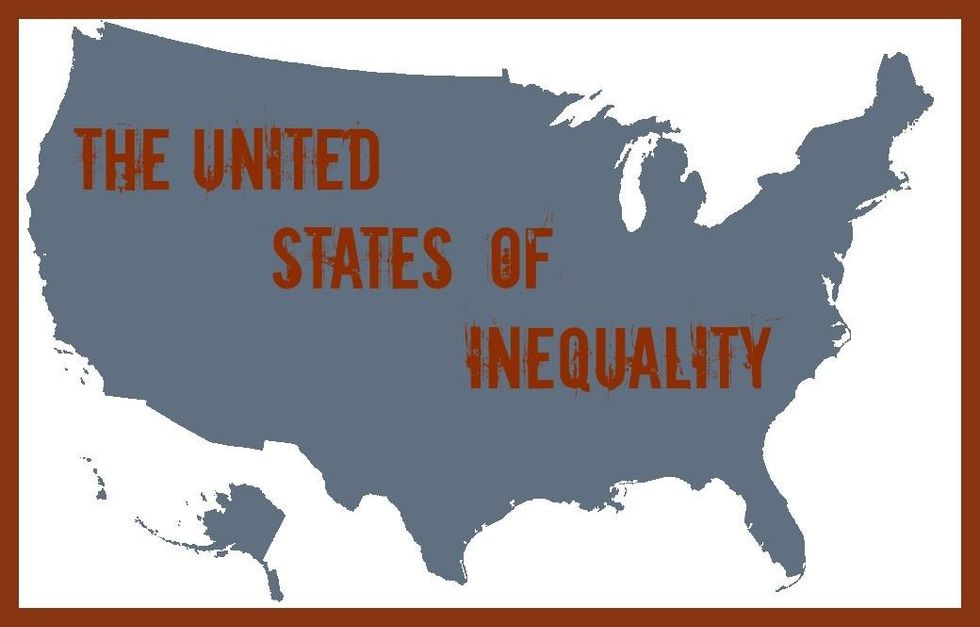The United States of Poverty and Inequality
New report shows that no matter which state you live in, the 1% are making even more gains as the rest fall back

This is all based on a new state-level study, The Increasingly Unequal States of America: Income Inequality by State, which looks at how inequality has seized hold of the national economy both in the generation leading up to the great recession of 2008 and in the several years following where a so-called "recovery" was experienced by the financial elite while the majority of U.S. population continues to claw its way back.
"The levels of inequality we are seeing across the country provide more proof that the economy is not working for the vast majority of Americans and has not for decades," said Mark Price, an economist at the Keystone Research Center, who co-authored the report on behalf of the Economic Analysis and Research Network (EARN). "It is unconscionable that most of America's families have shared in so little of the country's prosperity over the last several decades."
Check out the interactive state-by-state map on inequality generated by the study's authors.
Numerous studies in recent years have exposed the persistent pattern of income and wealth inequality in the United States, but as Price's co-author Estelle Sommeiller explains, "our study shows that this one percent economy is not just a national story but is evident in every state, and every region."
Though some states show higher levels of inequality, the pattern nationally is firm. What is also made clear by the study is the degree to which specific policies--including the writing of tax law, the climate set for labor conditions, and the setting of wages--have all contributed directly to this pattern where those at the very top benefit from a growing economy and those at the bottom receive increasingly less reward for their hard work.
"It's clear that policies were set to favor the one percent and those policies can, and should, be changed," Doug Hall, director of the EARN program said. "In order to have widespread income growth, bold policies need to be enacted to increase the minimum wage, create low levels of unemployment, and strengthen the rights of workers to organize."
Among the report's key findings:
- In four states (Nevada, Wyoming, Michigan, and Alaska), only the top 1 percent experienced rising incomes between 1979 and 2007, and the average income of the bottom 99 percent fell.
- In another 15 states the top 1 percent captured between half and 84 percent of all income growth between 1979 and 2007. Those states are Arizona (where 84.2 percent of all income growth was captured by the top 1 percent), Oregon (81.8 percent), New Mexico (72.6 percent), Hawaii (70.9 percent), Florida (68.9 percent), New York (67.6 percent), Illinois (64.9 percent), Connecticut (63.9 percent), California (62.4 percent), Washington (59.1 percent), Texas (55.3 percent), Montana (55.2 percent), Utah (54.1 percent), South Carolina (54.0 percent), and West Virginia (53.3 percent).
- In the 10 states in which the top 1 percent captured the smallest share of income growth, the top 1 percent captured between about a quarter and just over a third of all income growth. Those states are Louisiana (where 25.6 percent of all income growth was captured by the top 1 percent), Virginia (29.5 percent), Iowa (29.8 percent), Mississippi (29.8 percent), Maine (30.5 percent), Rhode Island (32.6 percent), Nebraska (33.5 percent), Maryland (33.6 percent), Arkansas (34.0 percent), and North Dakota (34.2 percent).
___________________________________
An Urgent Message From Our Co-Founder
Dear Common Dreams reader, The U.S. is on a fast track to authoritarianism like nothing I've ever seen. Meanwhile, corporate news outlets are utterly capitulating to Trump, twisting their coverage to avoid drawing his ire while lining up to stuff cash in his pockets. That's why I believe that Common Dreams is doing the best and most consequential reporting that we've ever done. Our small but mighty team is a progressive reporting powerhouse, covering the news every day that the corporate media never will. Our mission has always been simple: To inform. To inspire. And to ignite change for the common good. Now here's the key piece that I want all our readers to understand: None of this would be possible without your financial support. That's not just some fundraising cliche. It's the absolute and literal truth. We don't accept corporate advertising and never will. We don't have a paywall because we don't think people should be blocked from critical news based on their ability to pay. Everything we do is funded by the donations of readers like you. Will you donate now to help power the nonprofit, independent reporting of Common Dreams? Thank you for being a vital member of our community. Together, we can keep independent journalism alive when it’s needed most. - Craig Brown, Co-founder |

This is all based on a new state-level study, The Increasingly Unequal States of America: Income Inequality by State, which looks at how inequality has seized hold of the national economy both in the generation leading up to the great recession of 2008 and in the several years following where a so-called "recovery" was experienced by the financial elite while the majority of U.S. population continues to claw its way back.
"The levels of inequality we are seeing across the country provide more proof that the economy is not working for the vast majority of Americans and has not for decades," said Mark Price, an economist at the Keystone Research Center, who co-authored the report on behalf of the Economic Analysis and Research Network (EARN). "It is unconscionable that most of America's families have shared in so little of the country's prosperity over the last several decades."
Check out the interactive state-by-state map on inequality generated by the study's authors.
Numerous studies in recent years have exposed the persistent pattern of income and wealth inequality in the United States, but as Price's co-author Estelle Sommeiller explains, "our study shows that this one percent economy is not just a national story but is evident in every state, and every region."
Though some states show higher levels of inequality, the pattern nationally is firm. What is also made clear by the study is the degree to which specific policies--including the writing of tax law, the climate set for labor conditions, and the setting of wages--have all contributed directly to this pattern where those at the very top benefit from a growing economy and those at the bottom receive increasingly less reward for their hard work.
"It's clear that policies were set to favor the one percent and those policies can, and should, be changed," Doug Hall, director of the EARN program said. "In order to have widespread income growth, bold policies need to be enacted to increase the minimum wage, create low levels of unemployment, and strengthen the rights of workers to organize."
Among the report's key findings:
- In four states (Nevada, Wyoming, Michigan, and Alaska), only the top 1 percent experienced rising incomes between 1979 and 2007, and the average income of the bottom 99 percent fell.
- In another 15 states the top 1 percent captured between half and 84 percent of all income growth between 1979 and 2007. Those states are Arizona (where 84.2 percent of all income growth was captured by the top 1 percent), Oregon (81.8 percent), New Mexico (72.6 percent), Hawaii (70.9 percent), Florida (68.9 percent), New York (67.6 percent), Illinois (64.9 percent), Connecticut (63.9 percent), California (62.4 percent), Washington (59.1 percent), Texas (55.3 percent), Montana (55.2 percent), Utah (54.1 percent), South Carolina (54.0 percent), and West Virginia (53.3 percent).
- In the 10 states in which the top 1 percent captured the smallest share of income growth, the top 1 percent captured between about a quarter and just over a third of all income growth. Those states are Louisiana (where 25.6 percent of all income growth was captured by the top 1 percent), Virginia (29.5 percent), Iowa (29.8 percent), Mississippi (29.8 percent), Maine (30.5 percent), Rhode Island (32.6 percent), Nebraska (33.5 percent), Maryland (33.6 percent), Arkansas (34.0 percent), and North Dakota (34.2 percent).
___________________________________

This is all based on a new state-level study, The Increasingly Unequal States of America: Income Inequality by State, which looks at how inequality has seized hold of the national economy both in the generation leading up to the great recession of 2008 and in the several years following where a so-called "recovery" was experienced by the financial elite while the majority of U.S. population continues to claw its way back.
"The levels of inequality we are seeing across the country provide more proof that the economy is not working for the vast majority of Americans and has not for decades," said Mark Price, an economist at the Keystone Research Center, who co-authored the report on behalf of the Economic Analysis and Research Network (EARN). "It is unconscionable that most of America's families have shared in so little of the country's prosperity over the last several decades."
Check out the interactive state-by-state map on inequality generated by the study's authors.
Numerous studies in recent years have exposed the persistent pattern of income and wealth inequality in the United States, but as Price's co-author Estelle Sommeiller explains, "our study shows that this one percent economy is not just a national story but is evident in every state, and every region."
Though some states show higher levels of inequality, the pattern nationally is firm. What is also made clear by the study is the degree to which specific policies--including the writing of tax law, the climate set for labor conditions, and the setting of wages--have all contributed directly to this pattern where those at the very top benefit from a growing economy and those at the bottom receive increasingly less reward for their hard work.
"It's clear that policies were set to favor the one percent and those policies can, and should, be changed," Doug Hall, director of the EARN program said. "In order to have widespread income growth, bold policies need to be enacted to increase the minimum wage, create low levels of unemployment, and strengthen the rights of workers to organize."
Among the report's key findings:
- In four states (Nevada, Wyoming, Michigan, and Alaska), only the top 1 percent experienced rising incomes between 1979 and 2007, and the average income of the bottom 99 percent fell.
- In another 15 states the top 1 percent captured between half and 84 percent of all income growth between 1979 and 2007. Those states are Arizona (where 84.2 percent of all income growth was captured by the top 1 percent), Oregon (81.8 percent), New Mexico (72.6 percent), Hawaii (70.9 percent), Florida (68.9 percent), New York (67.6 percent), Illinois (64.9 percent), Connecticut (63.9 percent), California (62.4 percent), Washington (59.1 percent), Texas (55.3 percent), Montana (55.2 percent), Utah (54.1 percent), South Carolina (54.0 percent), and West Virginia (53.3 percent).
- In the 10 states in which the top 1 percent captured the smallest share of income growth, the top 1 percent captured between about a quarter and just over a third of all income growth. Those states are Louisiana (where 25.6 percent of all income growth was captured by the top 1 percent), Virginia (29.5 percent), Iowa (29.8 percent), Mississippi (29.8 percent), Maine (30.5 percent), Rhode Island (32.6 percent), Nebraska (33.5 percent), Maryland (33.6 percent), Arkansas (34.0 percent), and North Dakota (34.2 percent).
___________________________________

